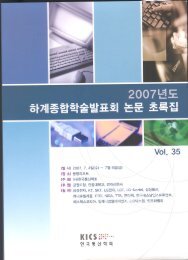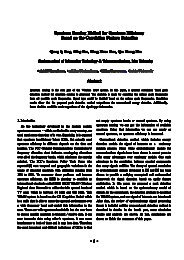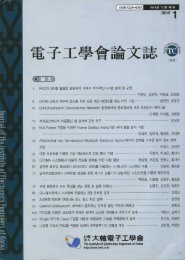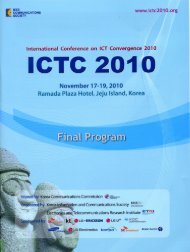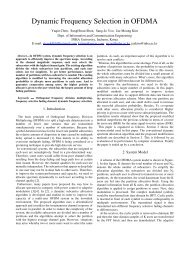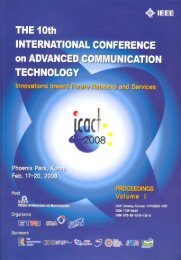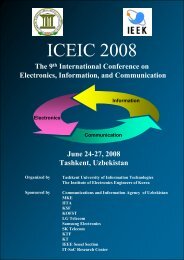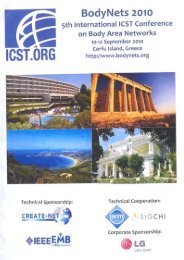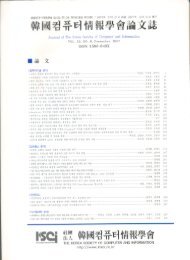Untitled
Untitled
Untitled
Create successful ePaper yourself
Turn your PDF publications into a flip-book with our unique Google optimized e-Paper software.
−1<br />
2<br />
H ⎛ H σ ⎞ w<br />
m = m ⎜ m m + 2 q⎟<br />
σ x<br />
g h H H I<br />
⎝ ⎠<br />
where I q is the q-by-q identity matrix. And moreover, we have<br />
N 1<br />
2<br />
σ x ( 1 m<br />
m 0<br />
−<br />
∑<br />
=<br />
MMSE = −gh<br />
m)<br />
(24)<br />
(25)<br />
By reducing the number of equalizer’s taps, the calculation<br />
complexity is reduced largely.<br />
VI. SIMULATION RESULT<br />
In our simulations, we investigate the performance of both the<br />
ZF equalizer and MMSE equalizer. A three-path BEM channel<br />
was considered. Other parameters are listed below:<br />
Tab. 1. Simulation parameter.<br />
Doppler spread fmax<br />
100 Hz<br />
Delay spread τmax 65.1 µ s<br />
Block size N 768<br />
Symbol/sample period T 21.7 µ s<br />
Discrete Doppler spread Q/2=<br />
⎡⎢ fmax NT ⎤⎥<br />
2<br />
Discrete delay spread L=<br />
max /T τ ⎡⎢ ⎤⎥<br />
3<br />
Note that the maximum Doppler spread of 100Hz corresponds<br />
to a vehicle speed of 60 km/h and a carrier frequency of 1.35GHz.<br />
BER<br />
BER<br />
1.00E+00<br />
1.00E-01<br />
1.00E-02<br />
1.00E-03<br />
1.00E-04<br />
1.00E-05<br />
0 1 2 3 4 5 6 7 8 9 10 11 12 13 14 15 16 17 18<br />
1.00E+00<br />
1.00E-01<br />
1.00E-02<br />
1.00E-03<br />
1.00E-04<br />
1.00E-05<br />
Ebn0(dB)<br />
ICI+no equalization<br />
ZF(tap=3)<br />
ZF(tap=5)<br />
no ICI+ZF equalization<br />
Fig.4. BER performance of the Zero-Forcing equalizer.<br />
0 1 2 3 4 5 6 7 8 9 10 11 12 13 14 15<br />
Ebn0(dB)<br />
ICI+no equalization<br />
MMSE(tap=3)<br />
MMSE(tap=5)<br />
no ICI+MMSE equalization<br />
Fig. 5 BER performance of the MMSE equalizer.<br />
Fig.4 and Fig.5 illustrate the BER performance of ZF and<br />
MMSE equalization respectively. The number of subcarrier is<br />
1024, and 3-tap, 5-tap ZF and MMSE equalizers are considered.<br />
The figures show that the 5-tap equalizer has better performance<br />
than 3-tap one. So we can change the number of equalizer’s tap to<br />
get the tradeoff between the complexity and performance.<br />
VII. CONCLUSION<br />
In this paper, we have utilized the basis expansion model (BEM)<br />
to get a good comprise between complexity and performance in<br />
conventional frequency domain equalizer. Both ZF and MMSE<br />
equalization are considered.<br />
This research was supported by University IT Research Center<br />
Project (INHA UWB-ITRC), Korea<br />
REFERENCE<br />
[1] S. Kim, and G. J. Pottie, “Robust OFDM in Fast Fading<br />
Channels,” Global Telecommunications Conference, vol. 2, pp.<br />
1074-1078, Dec. 2003.<br />
[2] P. Schniter and S. D’silva, “Low-Complexity Detection of<br />
OFDM in Doubly-Dispersive channels,” in Proc. Asilomar Conf.<br />
on Signals, Systems, and Computers, (Pacific Grove, CA), Nov.<br />
2002.<br />
[3] J. Armstrong, “Analysis of New and Existing Methods of<br />
Reducing Intercarrier Interference Due to Carrier Frequency<br />
Offset in OFDM,” IEEE Trans. Commun., vol. 47, pp. 365-369,<br />
Mar.1999.<br />
[4] G. B. Giannakis and C. Tepedelenlioglu, “Basis Expansion<br />
Models and Diversity Techniques for Blind Identification and<br />
Equalization of Time-Varying Channels,” Proc. IEEE, vol. 86, no.<br />
10, pp. 1969-1986, Oct.1998.<br />
[5] M. C. Jeruchim, P. Balaban, and K. S. Shanmugan,<br />
“Simulation of Communication Systems Modeling,<br />
Methodology, and Techniques, (Second Edition)” KLUWER<br />
ACADEMIC/PLENUM PUBLISHERS, second edition, pp.550-554,<br />
2000.<br />
[6] W. G. Jeon, K.H. Chang, and Y. S. Cho, “An Equalization<br />
Technique for Orthogonal Frequency-Division Multiplexing<br />
Systems in Time-Variant Multipath Channels,” IEEE Trans.<br />
Commun., vol. 47, no. 1, pp. 27-32, Jan. 1999.<br />
[7] I. Barhumi, G. Leus and M. Moonen, “Time-Varying FIR<br />
Equalization for Doubly Selective Channels,” IEEE Trans.<br />
Commun., vol. 4, no. 1, pp.202-214, Jan. 2005.



